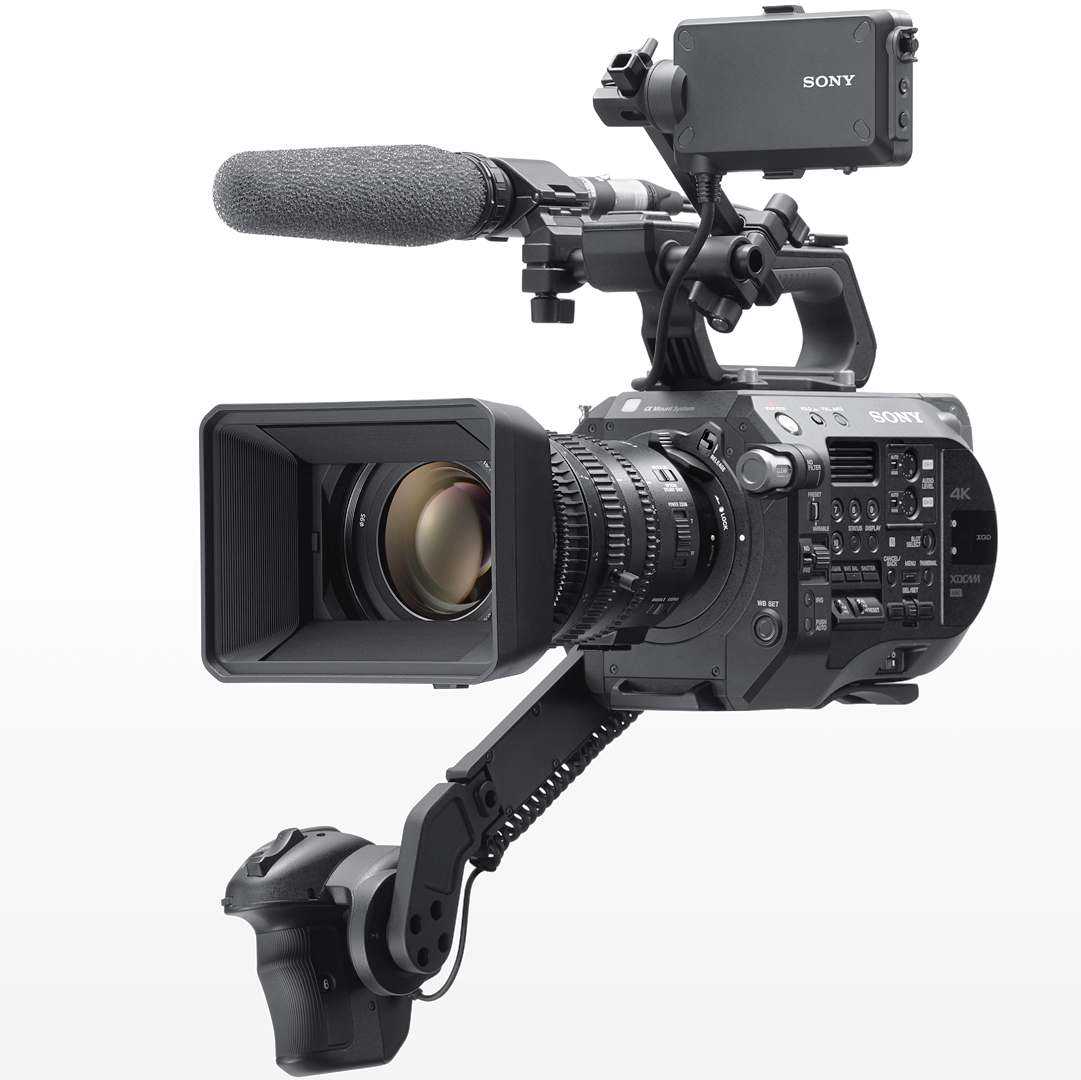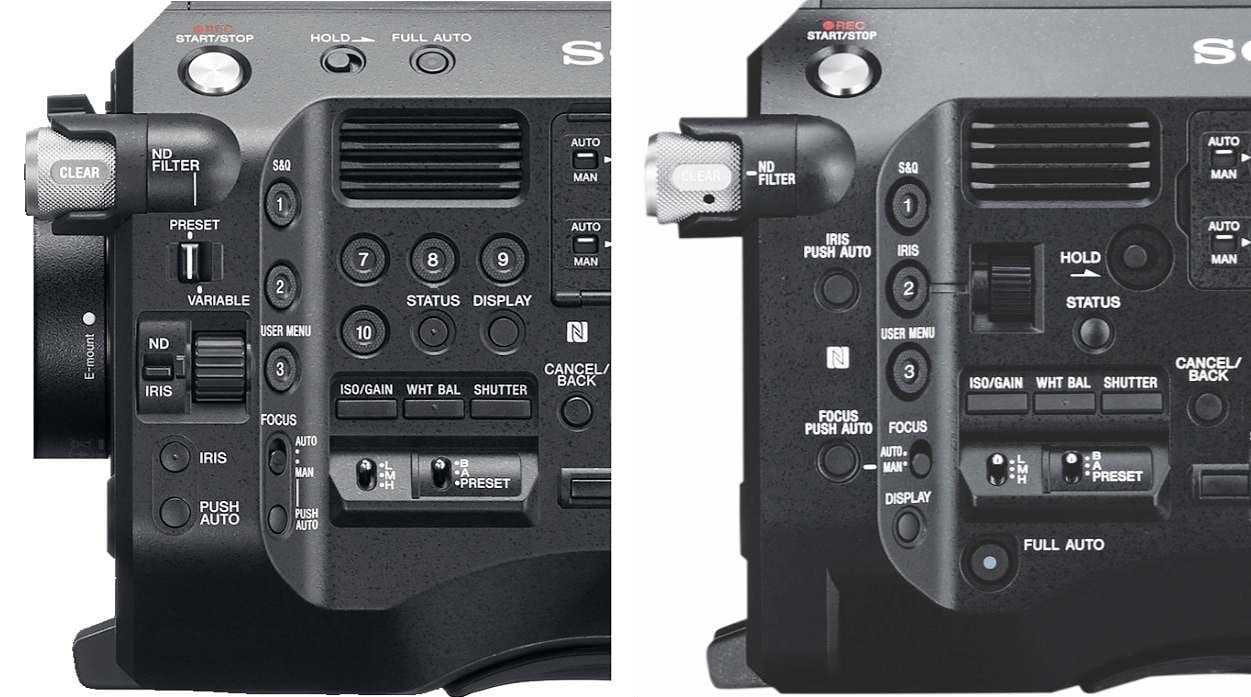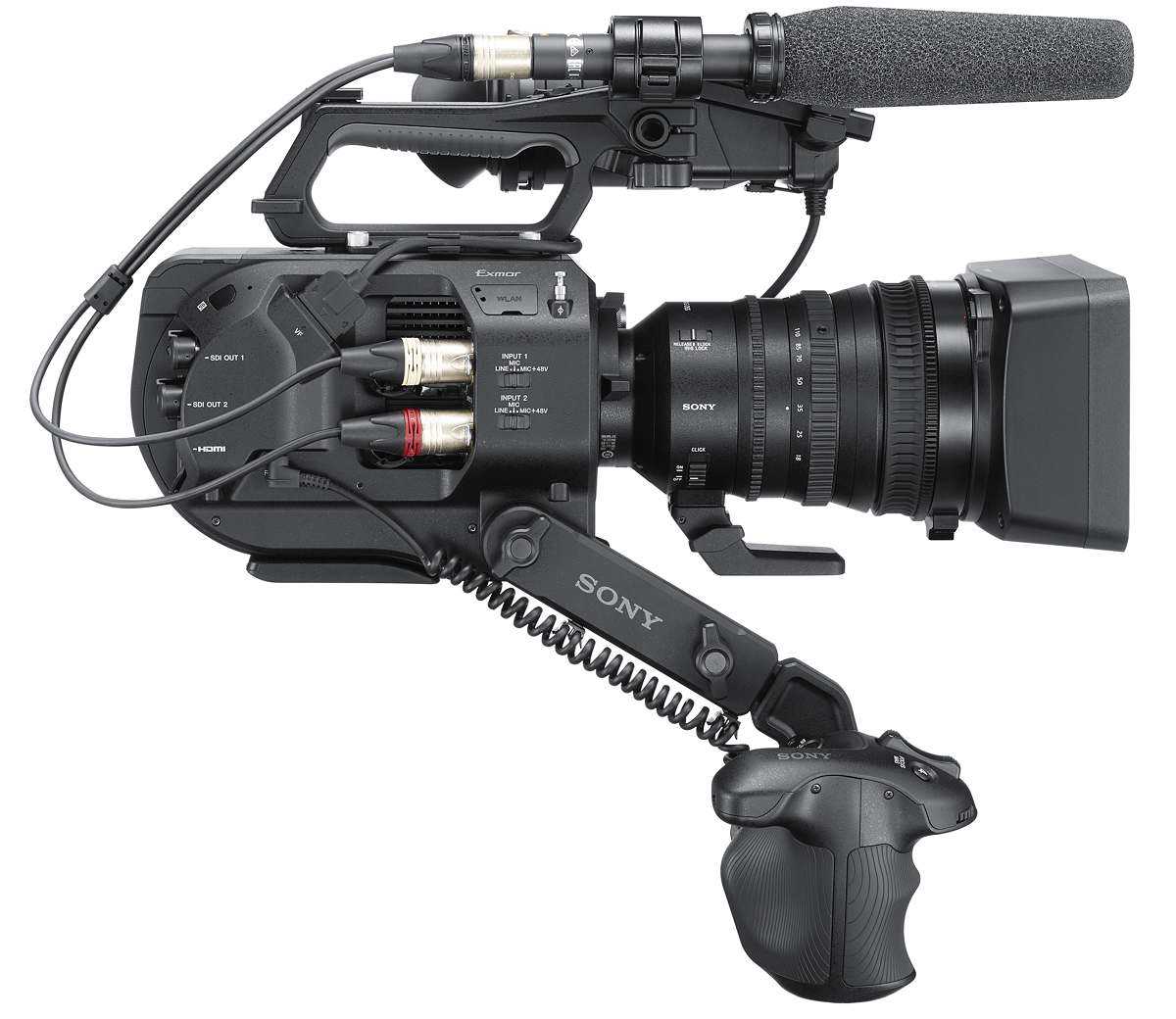Νέα και ωραία. Αυτή είναι η FS7 II. Με variable ND φίλτρο όπως η PXW-FS5, positive-locking E-mount, καλύτερο EVF mounting σύστημα, tool-less Smart Grip arm μηχανισμό extension, υποστήριξη Rec.2020 color Και όχι μόνο:
Νέος μηχανισμός για τις XQD, αλλαγές στην πόρτα audio control ενώ η FS7 II μπορεί να χρησιμεύσει καιως πλατφόρμα για αναβάθμιση του firmware των φακών E-mount lenses. Ο FS7 II kit φακός είναι ο SEL-P18110G F/4 OSS servo zoom, ένας $3500 18-100mm, cine/video-optimized φακός με παρόμοια σχεδίαση με τον 28-135mm f/4 της original FS7.
Είναι ο 6.1x, Super35mm-optimized αδερφός δηλαδή του 4.8x φακού, ιδανικός compact ζουμ για μια full-frame 35mm. Τι είναι δηλαδή η FS7 II; μια “deluxe” έκδοση της FS7. Η δε original FS7 παραμένει στη γκάμε με firmware update να αναμένεται και premium τιμή: στα $10,000, με το camera kit με τον 18-100mm στα $13,000.
Introduced by Sony in 2014, the FS7 has rapidly become one of the most popular production cameras in the industry.
Sony is now expanding its FS series of camcorders by introducing an advanced model, the FS7 II. The original FS7 remains in the lineup as the entry model to this growing family.
The FS7 II builds upon the proven FS7 platform, adding the latest, state-of-the-art Sony technology, including Electronic Variable ND and a “Lever Lock type” Sony’s Emount.
Lever Lock Type E-mount system
Sony’s new mount system securely locks E-mount lenses to the camera body and enables the use of larger, heavier lenses without need for additional support.
E-mount details
This breakthrough is based on a clever combination of advanced material science and ingenious engineering. The Lever-Lock Type E-Mount securely holds E-Mount lenses and adapters to the camera body. In fact, it can hold unsupported: Long, cine and zoom lenses of similar weight to unsupported PL-Mount lenses on the F55 (under static and dynamic loading).
Operating the FS7 II Lever Lock Type E-mount is similar to operating the PL-Mount common to cinema cameras.
Place the E-Mount lens in the Lever Lock Type E-Mount opening and then, with your free hand, rotate the locking ring in a counterclockwise direction. This securely clamps the E-Mount lens in the mount. When the ring comes to a stop, a secondary latch automatically locks the ring in place to prevent unintentional disengagement. To disconnect the lens, switch off the secondary latch, then rotate the locking ring in the clockwise direction to release the lens.
All the usual benefits of the E-Mount are retained.
Electronic Variable ND
Sony’s unique new Electronic Variable ND technology, first introduced in the FS5, provides “run and gun” filmmakers with a whole new means to seamlessly adjust exposure while shooting.
Variable ND frees the lens iris from the traditional job of exposure control. With Variable ND, the lens iris can be dedicated instead to the important job of setting depth-of-field. In documentary field work, bright exteriors and dim interiors no longer need automatically result in distracting variations in depth-of-field.
Variable ND also permits any lens to be used consistently at its “sweet spot,” within its best f-stop or T-stop range (peak optical performance for that particular lens). In so doing, Variable ND avoids the image degradation and softening that typically accompanies opening or closing the lens iris too much.
The PXW-FS7 II offers three different Variable ND operation modes: Preset Variable ND, Manual Variable ND and Auto Variable ND. Large, easily accessible switches on the front side of the camera permit quick switching between these modes with the camera on the operator’s shoulder.
Preset Variable ND
The ND turret knob enables four presets for ND attenuation. The first preset is “clear,” in other words, no ND. That leaves three preset settings, which are user-selectable in 1/3 stop steps within the camera’s 2 to 7 stop range.
For example, each of the three user-selectable ND presets might be set to a desired ND density for each of three particular scenes, which, in combination with iris settings, could give each scene a particular look with regard to depth-of-field.
Manual Variable ND
This mode is ideal for “run and gun shooting.” The operator can manually adjust exposure by turning either a knurled wheel near the front of the camera or an index-finger wheel on the SmartGrip. In either case, the result is a smooth, seamless adjustment of exposure within a 2 to 7 stop attenuation range. Both control wheels can be user-assigned to control ND density–or one of them can be reassigned to adjust audio level or lens iris.
Auto Variable ND
Auto ND can entirely replace the Auto Iris function, without any of the aforementioned optical aberrations or degradations caused by changes of iris aperture. Auto ND will prove incredibly useful to a single-person crew shooting nature or conducting interviews outside while the sun comes in and out from behind the clouds. Another critical new use of Auto Variable ND will be for shooting time-lapse of sunsets and sunrises, to ensure a steadily compensating exposure where desired.
Note that any of the 10 assignable buttons on the FS7 II can be assigned to toggle “Auto ND” on/off. This function could be used, for instance, to let the FS7 II quickly establish a ballpark exposure setting, which could then be manually trimmed to taste.
Lastly, the FS7 II’s new Variable ND feature encourages the use of any lens not commonly used in hand-held vérité documentary filmmaking due to the challenges of manually changing exposure while following the action. This particularly applies to older DSLR lenses for which active E-Mount adapters exist. Given their DSLR heritage, their iris aperture often changes in coarse 1/3 stop steps only.
Evolution of Platform
The third major development in the FS7 II concerns improved ergonomics and mechanical design.
A more efficient and versatile operator control layout
Buttons and controls are placed at intuitive locations for easy access while shooting. The operator side of the camera now also includes all the necessary controls for operating the new Variable ND feature. And the number of assignable buttons has increased from six to ten.
FS7 II on left, original FS7 on right
FS7 II on left, original FS7 on right
A more efficient and versatile viewfinder system
The viewfinder is the most important camera-operator interface, used for framing every shot. The viewfinder eyepiece, when in use, also provides a contact point for stabilizing the camera while shooting handheld.
The FS7 II’s new stronger, simpler viewfinder support bracket makes possible quick and easy fine-tuning of the viewfinder’s position–or choosing a radical reconfiguration. To simplify operation, the FS7’s original single lever clamp system is replaced by a double clamp with discrete clamping knobs for both front-to-back and vertical height adjustment. This new design facilitates adjusting the viewfinder while shouldering the camera.
Another FS7 II viewfinder bracket innovation is use of square rods which retain LCD horizontal alignment.
square rods for the EVF mount
square rods for the EVF mount
Attaching the eyepiece to the FS7 II’s LCD is simpler and easier. The FS7’s eyepiece top latch is replaced by a fixed rectangular steel loop that instantly hooks the eyepiece flush and level, perfectly aligned to the LCD; just secure the bottom latch and you’re good to go.
The FS7 II’s eyepiece uses an industry-standard 52mm diopter. By removing the rubber eyecup, the original diopter is easily switched out for a diopter matching the operator’s eyeglass prescription. This is a common request of many experienced camera operators.
The FS7 II introduces a collapsible LCD hood for viewing the LCD without the eyepiece.
The FS7 II’s mic holder is no longer permanently attached to the end of the short 15mm rod that acts as a cross bar to join the viewfinder support bracket and the mic holder to the front of the handle. The mic holder’s lever clamp now enables removing, reorienting, or relocating the mic holder.
Furthermore, this short 15mm rod can now be replaced for a longer one that enables relocating the viewfinder eyepiece further out for “left eye dominant” operators.
Another benefit of the FS7 II mic holder removable clamping system is that the viewfinder and mic holder can be transposed in seconds to the opposite side.
FS7 II with flipped EVF and mic holder
This enables the operator to comfortably shoot from the camera’s right side. This feature is often requested by experienced 16mm camera operators who once enjoyed the same flexibility from their Aatons and ARRI SRs.
A smarter SmartGrip arm
The length of the FS7 II’s SmartGrip can be changed without any tools. The new design uses knobs contoured to facilitate locking and loosening by hand, even when wearing gloves. Furthermore, the new design enables relocating the SmartGrip to a new position, closer to the camera body. This makes it easier to hold the FS7 II against the chest or underarm to permit shooting more comfortably, from more angles.
Media easier to eject
XQD cards now project twice as much from their slots in order to facilitate card changeover, even while wearing gloves.
Signal Processing
The FS7 II is built upon the proven FS7 platform. The sensor, ISO sensitivity, and colorimetry specifications carry over.
The FS7 II also has two signal processing modes: Cine-EI and Custom. Cine-EI offers three color grading spaces for electronic cinematography production. Custom mode hosts broadcast standards; until now, Custom Mode supported ITU Rec. BT‑709, HD standard.
A recently adopted signal distribution and display standard, the ITU Rec.BT 2020 defines various aspects of UHDTV such as display resolution, frame rate, chroma subsampling, bit depth and color space.
In keeping with the times, the FS7 II adds BT‑2020 at UHDTV 3840 x 2160 display resolution and Y, Cb, Cr color subsampling to the Custom Mode. It is possible to record onboard and monitoring on BT 2020 compliant monitors via HDMI 10-bit 422 or SDI at 10-bit 422 with a 709 monitor LUT applied.
SEL-P18110G F/4 OSS servo zoom lens
Sony is introducing a second E-Mount, Super 35mm Servo Zoom lens: the SEL-P18110G.
This lens covers Super35mm & APSC sensors. It is compatible with Sony α Mount System cameras, including the α7 series interchangeable-lens cameras and professional Super 35mm 4K camcorders like Sony’s FS7 or FS5.
This 2nd generation servo zoom lens incorporates significant developments for motion picture production: Snap zooms are possible due to a fully mechanical zoom system and Sony Smooth Motion Optics (SMO) design features.
The SEL-P18110G is compact and lightweight -2.4lbs – with a tough magnesium-alloy metal body and a highly practical 18 to 110mm focal range (6.1x zoom). Its wide zoom range and close minimum object distance enables following of the action from up close or far away; an extremely useful feature for Cinéma Vérité style filmmaking
Sony’s SMO design, developed to optimize performance for motion image filmmaking, offers the following advantages:
No Ramping: The F stop does not change when zooming in.
Parfocal: The lens holds focus while zooming.
No Breathing: The image size does not change or appear to zoom while focusing.
No optical axis shifting: The image does not move in the frame while zooming.
Use of very precise, smooth and quiet iris zoom and focus motors.Optical performance is Sony G Lens™ class; similar to the FE-PZ2813 G. State of the art optical materials and manufacturing are employed featuring: 18 elements in a 15 group construction including six aspherical elements, three ED Glass elements plus multi-coating for low flare, high contrast and exceptional optical performance.
Filmmakers will fully appreciate the lens’ extended creative capabilities for shooting motion images:
Internal focus, parfocal, high contrast, sharp to the edges, with circular Iris aperture for beautiful bokeh, maintains constant F4 maximum aperture and is dust and moisture resistant
Non-perceptible: breathing, ramping, optical axis deviation, lateral and longitudinal chromatic aberrations or Seidel aberrations: spherical, coma, astigmatism, curvature of field and distortion.
Discrete Iris, Zoom & Focus rings with markings on the barrel.
The manual focus ring includes a Cine-Style 0.8mm pitch gear, compatible with follow focus and external motor drives.
The push-pull focus ring seamlessly switches between auto and manual without removing your hand from the lens barrel.
The mechanical zoom ring has a predictable linear response; is fully capable of snap zooms and is entirely devoid of lag. The direction of the zoom ring rotation is reversible.
Maximum ring rotation: Focus 240°, Zoom & iris 90°are ideal for “running and gunning” yet wide enough for precise narrative style productions.
The Iris aperture can be manually changed in 1/3 stop increments when “Click” is engaged. Click-less and servo mode operation enable super smooth iris pulls by seamlessly varying aperture with 1/128th stop precision.
Selectable Auto / Manual Focus & Optical SteadyShot (Image stabilizer).
The supplied Sunshade has a built-in louver style lens cap mechanism. A traditional circular cap is also supplied for use when the louver sunshade is not used.
Full lens metadata transfer to the camera for display on the VF and real-time recording onto the file (Sony formats only).
Extensive refinements to the viewfinder support system and SmartGrip arm mechanism ensure super-fast and secure “on the run” rig repositioning–all of this while still retaining the Zen-like simplicity, flexibility and operational comfort of the FS7’s “multi-award winning” industrial design.
Related posts
Categories
- android World
- cinemart / music / video
- comicmania / books
- computing / social media
- consumer electronics
- design / architecture
- ecotech / electric
- exhibitions
- faq / Infographics
- futuristas / iDea
- gadgetfreak taste
- gadgets / stuff
- gaming / fun
- iOS World
- legends / special
- men's world
- military / aviation
- mobile / smartphones
- space talk
- tablets / multimedia
- tech talk / science
- transport / concept





